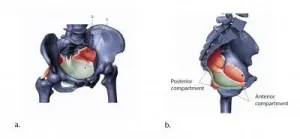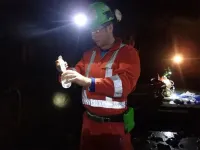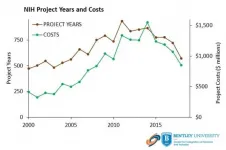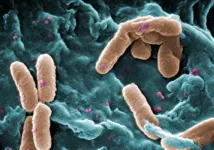INFORMATION:
Scientists unmask new neutralizing antibody target on SARS-CoV-2 spike protein
SARS-CoV-2 can recruit a haem metabolite to evade antibody immunity
2021-04-22
(Press-News.org) Researchers have identified another potential target for neutralizing antibodies on the SARS-CoV-2 Spike protein that is masked by metabolites in the blood. As a result of this masking, the target may be inaccessible to antibodies, because they must compete with metabolite molecules to bind to the otherwise open region, the study authors speculate. This competitive binding activity may represent another method of immune evasion by the SARS-CoV-2 virus. Although further validation work is needed, the findings suggest that strategies to unmask this region - thus making it more visible and accessible to antibodies - may help lead to new vaccine designs. To date, the majority of neutralizing antibodies characterized in COVID-19 patients are those that bind the receptor binding domain of the SARS-CoV-2 Spike protein, while much less is known about the structure of - and antibody interactions with - the Spike's N-terminal domain (NTD). Using cryo-electron microscopy and X-ray crystallography, Annachiara Rosa and colleagues mapped a deep cleft of the N-terminal domain, showing that a specific pocket in the cleft binds the blood metabolite biliverdin with high affinity. This activity leads to stabilization of the NTD structure and "hides" the Spike protein site from binding and neutralization by a subset of human anti-Spike protein antibodies. Successful binding of antibodies to this Spike region requires conformational changes in the NTD that are inhibited by biliverdin binding. Addition of excess biliverdin to sera isolated from SARS-CoV-2-infected and convalescent individuals reduced the reactivity of the immune sera by as much as 50%. The results highlight the importance of this small pocket in the NTD for the stimulation of antibody immunity against SARS-CoV-2.
ELSE PRESS RELEASES FROM THIS DATE:
Why the human body has not evolved to make childbirth easier -- or has it?
2021-04-22
AUSTIN, Texas -- Despite advances in medicine and technology, childbirth isn't likely to get much easier on women from a biological perspective.
Engineers at The University of Texas at Austin and University of Vienna revealed in new research a series of evolutionary trade-offs that have created a near-perfect balance between supporting childbirth and keeping organs intact on a day-to-day basis. Human reproduction is unique because of the comparatively tight fit between the birth canal and baby's head, and it is likely to stay that way because of these competing biological imperatives.
The size of the pelvic floor and canal is key to keeping this balance. These opposing duties have constrained the ability of the pelvic floor to evolve over time to make childbirth easier because doing ...
A new method for fighting 'cold' tumors
2021-04-22
Not all cancerous tumors are created equal. Some tumors, known as "hot" tumors, show signs of inflammation, which means they are infiltrated with T cells working to fight the cancer. Those tumors are easier to treat, as immunotherapy drugs can then amp up the immune response.
"Cold" tumors, on the other hand, have no T-cell infiltration, which means the immune system is not stepping in to help. With these tumors, immunotherapy is of little use.
It's the latter type of tumor that researchers Michael Knitz and radiation oncologist and University of Colorado Cancer Center member Sana Karam, MD, PhD, address in new research published this week in the Journal for ImmunoTherapy of Cancer. Working with mouse models in Karam's specialty area of head and neck cancers, Knitz and ...
Mars has right ingredients for present-day microbial life beneath its surface, study finds
2021-04-22
PROVIDENCE, R.I. [Brown University] -- As NASA's Perseverance rover begins its search for ancient life on the surface of Mars, a new study suggests that the Martian subsurface might be a good place to look for possible present-day life on the Red Planet.
The study, published in the journal Astrobiology, looked at the chemical composition of Martian meteorites -- rocks blasted off of the surface of Mars that eventually landed on Earth. The analysis determined that those rocks, if in consistent contact with water, would produce the chemical energy needed to support microbial communities similar to those that survive in the unlit depths of the Earth. Because these meteorites may be representative ...
COVID-19 vaccine development built on >$17 billion in NIH funding for vaccine technologies
2021-04-22
The unprecedented development of COVID-19 vaccines less than a year after discovery of this virus was enabled by more than $17 billion of research on vaccine technologies funded by the NIH prior to the pandemic, according to new research from Bentley University's Center for Integration of Science and Industry. The article, titled "NIH funding for vaccine readiness before the COVID-19 pandemic," demonstrates the critical role this broad foundation of government-funded research plays in ensuring vaccine readiness.
The report, published today in the journal Vaccine, ...
Blacks, hispanics, impoverished have worse survival rates among teens, adults under 40 with cancer
2021-04-22
DALLAS - April 22, 2021 - Being Black or Hispanic, living in high-poverty neighborhoods, and having Medicaid or no insurance coverage are associated with higher mortality in men and women under 40 with cancer, a review by UT Southwestern Medical Center researchers found.
"Survival is not different because of biology. It's not different because of patient-level factors," says Caitlin Murphy, Ph.D., lead author of the study and an assistant professor of population and data sciences and internal medicine at UT Southwestern. "No matter which way we looked at the data, we still saw consistent and alarming differences in survival by race - and these are teens and young adults."
Other findings based on an ...
Can machine learning improve debris flow warning?
2021-04-22
Machine learning could provide up an extra hour of warning time for debris flows along the Illgraben torrent in Switzerland, researchers report at the Seismological Society of America (SSA)'s 2021 Annual Meeting.
Debris flows are mixtures of water, sediment and rock that move rapidly down steep hills, triggered by heavy precipitation and often containing tens of thousands of cubic meters of material. Their destructive potential makes it important to have monitoring and warning systems in place to protect nearby people and infrastructure.
In her presentation at SSA, Ma?gorzata Chmiel of ETH Zürich described a machine learning approach to detecting and alerting against debris flows for the Illgraben torrent, a site in the European Alps that experiences significant debris flows and torrential ...
3D printed models provide clearer understanding of ground motion
2021-04-22
It seems like a smooth slab of stainless steel, but look a little closer, and you'll see a simplified cross-section of the Los Angeles sedimentary basin.
Caltech researcher Sunyoung Park and her colleagues are printing 3D models like the metal Los Angeles proxy to provide a novel platform for seismic experiments. By printing a model that replicates a basin's edge or the rise and fall of a topographic feature and directing laser light at it, Park can simulate and record how seismic waves might pass through the real Earth.
In her presentation at the Seismological Society of America (SSA)'s 2021 Annual Meeting, Park explained why these physical models can address some of the drawbacks of numerical modeling of ground motion in some cases.
Small-scale, complex structures in ...
Ground and satellite observations map building damage after Beirut explosion
2021-04-22
Days after the 4 August 2020 massive explosion at the port of Beirut in Lebanon, researchers were on the ground mapping the impacts of the explosion in the port and surrounding city.
The goal was to document and preserve data on structural and façade damage before rebuilding, said University of California, Los Angeles civil and environmental engineer Jonathan Stewart, who spoke about the effort at the Seismological Society of America (SSA)'s 2021 Annual Meeting.
The effort also provided an opportunity to compare NASA Jet Propulsion Laboratory satellite surveys of the blast effects with data collected from the ground surveys. Stewart and his colleagues concluded that satellite-based Damage Proxy Maps were effective at identifying severely damaged buildings and undamaged ...
Stress test finds cracks in the resistance of harmful hospital bugs
2021-04-22
Research has identified critical factors that enable dangerous bacteria to spread disease by surviving on surfaces in hospitals and kitchens.
The study into the mechanisms which enable the opportunistic human pathogen Pseudomonas aeruginosa to survive on surfaces, could lead to new ways of targeting harmful bacteria.
To survive outside their host, pathogenic bacteria must withstand various environmental stresses. One mechanism is the sugar molecule, trehalose, which is associated with a range of external stresses, particularly osmotic shock - sudden changes to the salt concentration surrounding cells.
Researchers ...
Researchers show how 'theory of mind' influences advertising skepticism
2021-04-22
EUGENE, Ore. -- April 22, 2021 -- Product marketers should be clear in their messaging to avoid customer skepticism that makes them feel duped, according to University of Oregon research.
At issue in a new study, published in the Journal of Business Research, was a social-cognitive construct called theory of mind, which considers how well people assess the mental states and apparent goals of others.
Developmental psychologists link it to an ability to show empathy. In business, the study, led by former UO doctoral student Elizabeth Minton, showed it also can influence a person's recognition of being persuaded. And that affects a person's evaluation and willingness to buy a product, she found.
"There has been some research on adult theory of mind, particularly in understanding ...
LAST 30 PRESS RELEASES:
Study showcases resilience and rapid growth of “living rocks”
Naval Research Lab diver earns Office of Naval Research 2025 Sailor of the Year
New Mayo-led study establishes practical definition for rapidly progressive dementia
Fossil fuel industry’s “climate false solutions” reinforce its power and aggravate environmental injustice
Researchers reveal bias in a widely used measure of algorithm performance
Alcohol causes cancer. A study from IOCB Prague confirms damage to DNA and shows how cells defend against it
Hidden viruses in wastewater treatment may shape public health risks, study finds
Unlock the power of nature: how biomass can transform climate mitigation
Biochar reshapes hidden soil microbes that capture carbon dioxide in farmland
Reducing saturated fat intake shows mortality benefit, but only in high-risk individuals
Manta rays create mobile ecosystems, study finds
Study: Mixed results in using lipoic acid to treat progressive multiple sclerosis
Norbert Holtkamp appointed director of Fermi National Accelerator Laboratory
New agentic AI platform accelerates advanced optics design
Biologists discover neurons use physical signals — not electricity — to stabilize communication
Researchers discover that a hormone can access the brain by hitchhiking
University of Oklahoma researcher awarded funding to pursue AI-powered material design
Exploring how the visual system recovers following injury
Support for parents with infants at pediatric check-ups leads to better reading and math skills in elementary school
Kids’ behavioral health is a growing share of family health costs
Day & night: Cancer disrupts the brain’s natural rhythm
COVID-19 vaccination significantly reduces risk to pregnant women and baby
The role of vaccination in maternal and perinatal outcomes associated with COVID-19 in pregnancy
Mayo Clinic smartwatch system helps parents shorten and defuse children's severe tantrums early
Behavioral health spending spikes to 40% of all children’s health expenditures, nearly doubling in a decade
Digital cognitive behavioral treatment for generalized anxiety disorder
Expenditures for pediatric behavioral health care over time and estimated family financial burden
Air conditioning in nursing homes and mortality during extreme heat
The Alps to lose a record number of glaciers in the next decade
What makes a good proton conductor?
[Press-News.org] Scientists unmask new neutralizing antibody target on SARS-CoV-2 spike proteinSARS-CoV-2 can recruit a haem metabolite to evade antibody immunity





